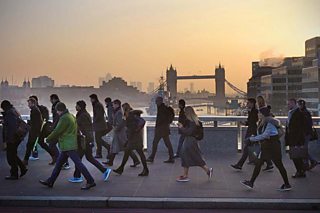
The working year is well under way and every day millions of commuters in Britain set out to make the best of two worlds: home and work. Follow how their experiences have been portrayed on TV and radio.
Ever since the extended our range beyond that of the horse and carriage, we’ve commuted ever greater distances between home and work. This deceptively simple return journey has always told us a lot about how we live and about the values we attach to work and home - and the lengths we’ll go to achieve the best of both worlds.
In 1959, the segment of In the South-East highlighted the one million-plus people who commuted daily to the capital. Housing wasn’t their only problem, they also faced social challenges. Questions were asked about the impact of their arrival on local communities in and ; and on farming in .

Model village: the making of a commuter utopia, in Living Room, part of the Modern Times series
However, the commuter belt continued to expand relentlessly, notch by notch. In 1970, featured a portrait of Brenchley, a commuter village in Kent, where there had been “more changes in the last 20 years than the previous 800”. By 1989, commuting was taking over as a way of life even in the most rural areas and raised concerns about commuting urban incomers being raised as far away as Wales. Development in rural Kent was a subject that didn't go away, as demonstrated by two programmes broadcast 34 years apart: in 1965, and in 1999.
Further back in time, if you expected a to have a season’s ticket and a briefcase, you would be wrong - by 100 million years. The title refers, in fact, to the dinosaurs that once roamed the then tropical swamps of Surrey, the subject of this four-part series on Radio 4.
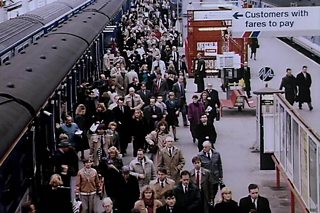
How did 20th-Century commuters feel about their journeys? Programme-makers went out to document their experiences in a variety of ways. In 1979, Network made the journey on board the in pictures, words and music. Molly Dineen’s Heart of the Angel for the series 40 Minutes traced 24 intense hours in the life of London’s Angel tube station, its travellers and staff. In , the country’s economic divide came under the spotlight as Northerners talked about the hardship and uncertainty of having to go South every week in search of work. Few – then and now - would disagree with from 1988 that found the whole business of commuting very stressful. By 2004, the idea of “time poverty” had taken hold and included a search for the individual who commutes the farthest.
British commuters have long asked whether they are getting a fair deal from rail companies and in 1993 Inside Story’s report about Network SouthEast, set out to “discover what lies behind the commuters' misery” but also showed the challenges faced by rail staff.

The train is not, of course, the commuter’s only option, although the emphasis in the listings is increasingly on public transport. Britain’s , were in 1965 already wondering if they were being priced out of their cars, and earlier that year had debated the virtues of buses versus cars. But not even the iconic Routemaster bus and its conductors could resist the march of progress and First Sight's joined commuters and crews on a valedictory journey. For many, “it's not just a bus but a social service that will be lost.”
We read Genome listings with 20-20 hindsight. Thus, we know the Routemaster name was revived but the bus was not the same. Similarly, Genome sometimes affords us a glimpse of an idea that only many years later became reality, like charging cars to drive in central London, mentioned in this 1966 profile of then Minister of Transport, .
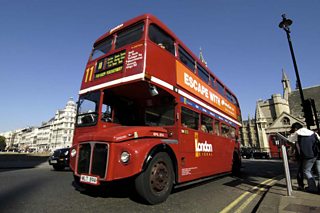
Commuting has provided plenty of rich material for radio and television dramatists: all those apparent strangers cooped up together with limitless possibilities for improbable chance meetings, like Frederic Raphael’s hero, Colin the “creative commuter” (David Suchet), and his greatest fan, Angela (Frances Tomelty) in . In The Commuters’ Tales, travellers on the Southern Region in 1971 pass their time like Chaucer's pilgrims by telling stories, including , and .
In 1975, Tom (Richard Briers) declared boldly that “commuting isn’t for the thinking man” and set out with Barbara (Felicity Kendall) to become self-sufficient in Surbiton and live , much to the horror of their neighbours Margo and Jerry (Penelope Keith and Paul Eddington).
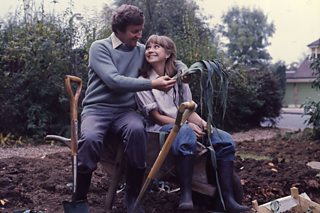
Plotting escape: Richard Briers and Felicity Kendall as Tom and Barbara in The Good Life
On the other hand, computer TD30X could only dream of commuting in the Radio 4 Christmas fantasy, . “I want to be human, not just compute. If only I could commute, then I would be free. To be human. I'd feel alive. If I could be 9 to 5. Then I'd be free.”
There is human yearning on the move, too. In , Barry Norman reviewed Falling in Love. Starring Meryl Streep and Robert De Niro, it was the greatest commuter romance since Brief Encounter. The itself was shown on �������� Two in 1992.
Commuting has created a whole new genre of radio programme. What we listen to on the way to and from work has been driven by the commuter’s need for information and aural companionship. In 1979, �������� Radio London’s with Susie Barnes proclaimed “London's brightest breakfast show starts your day with news, information, what's on and good music. The fastest travel service in town gets you to work easily whether you commute by car, train, boat or plane.” At the other end of the day, on Radio 2, got us home again with his Drive Time Show, complete with Mystery Voice competition.
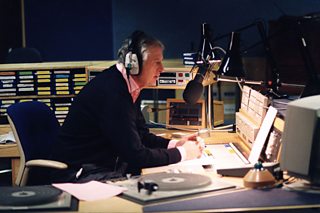
The voice of Drive Time: John Dunn, keeping us company on the way home
Life after commuting has always been a happy prospect, as demonstrated in March 2003, featuring Chris and Sue who hoped to escape London after “50 years of commuting have taken their toll”. And don’t we all dream of swapping our desk for a hammock on a faraway tropical island? (More difficult than you’d think, according to a former governor of .)
But how about a time when we don’t commute at all? In 1988, when the threatened to put an end to going into the office, it sounded like such a good idea, with the delightful prospect of working from home, uninterrupted and quite invisible in our pyjamas. But it didn’t quite turn out like that. Now we have video calling and all those helpful apps that let us work together remotely in real time. So, even at home, we’re still left with the commuter’s perennial problem: What am I going to wear to work today?
